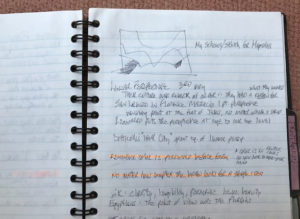 “First I have the picture” Einstein reportedly said, “then I come up with the math”. Before any of us knew how to decode language, our little eyes trained on images. Even the cones on our retinae respond to color before form is understood. We begin from image impression, but then sometimes the more we “know” what’s in front of us, the less we can wholly grasp.
“First I have the picture” Einstein reportedly said, “then I come up with the math”. Before any of us knew how to decode language, our little eyes trained on images. Even the cones on our retinae respond to color before form is understood. We begin from image impression, but then sometimes the more we “know” what’s in front of us, the less we can wholly grasp.
Educational theory has typed learners into all kinds of styles. Yet painter David Dunlop insists “We’re all visual learners”. He’s done a lot of reading on cognitive studies, some pattern theory, interest in pictographs, and he knows his art history. So, I was entirely engaged in a workshop he led this month. He mentioned that many painters (like Turner, Whistler, Manet, Monet) became more abstract, with distilled and simplified imagery as they grew older (and that later work was more universally evocative). Dunlop’s own work is quite literal and beautifully detailed, but I wasn’t there to copy him.
“We always ‘push off’ from an image in the head, a simple schema that gets us started”, then the magic happens after that as we work out from that impression.
What you see above is a thumbnail sketch out of my notebook. I quickly mapped the shapes,  darks and lights from a photo of a magnolia blossom. What was important in translating this into paint was not “this is a magnolia’ but rather more than that, and I needed to take time to consider how. My oil color is carefully selected. But what excites me is the emergent shine, and the impasto lending toward a sense of exuberance. The cropping too was a choice, as if I am just teasing the viewer into only a glimpse. Glimpses for me are key, for if I try to tell the whole story, we’ll all get lost in words. There’s an energy in this translation into color that springs off the canvas. Usually I dive into work from an idea in my head, but to take the time to map it first, if even so simply, is important, and more than I knew. I’ve heard about the necessity of sketchbook planning, but since I’m not much of a draftsman and am also impatient, I’ve often skipped that part. “I see said the blind man”. So this mapping process was a win for me, and it’s informing further practice.
darks and lights from a photo of a magnolia blossom. What was important in translating this into paint was not “this is a magnolia’ but rather more than that, and I needed to take time to consider how. My oil color is carefully selected. But what excites me is the emergent shine, and the impasto lending toward a sense of exuberance. The cropping too was a choice, as if I am just teasing the viewer into only a glimpse. Glimpses for me are key, for if I try to tell the whole story, we’ll all get lost in words. There’s an energy in this translation into color that springs off the canvas. Usually I dive into work from an idea in my head, but to take the time to map it first, if even so simply, is important, and more than I knew. I’ve heard about the necessity of sketchbook planning, but since I’m not much of a draftsman and am also impatient, I’ve often skipped that part. “I see said the blind man”. So this mapping process was a win for me, and it’s informing further practice.